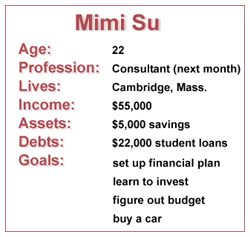|
MIT grad gets schooled
|
 |
August 21, 2000: 10:00 a.m. ET
Mimi Su wants to know how to spend her paycheck. Two planners tell her how
By Staff Writer Alex Frew McMillan
|
NEW YORK (CNNfn) - It won't be Mimi Su's first paycheck when the MIT grad starts her consulting job. She spent her summers on a series of internships, some of which paid quite well.
Su managed to save up $5,000 this summer, too. But Sept. 5 will mark the  start of her full-time career. She has decided to stay local, in Boston. She starts at $50,000, with a $5,000 signing bonus. start of her full-time career. She has decided to stay local, in Boston. She starts at $50,000, with a $5,000 signing bonus.
That's not as much as some of her MIT buddies will be making out the gate. Several are heading to spots such as Austin, Texas, where one software company is signing them at $100K base.
"I don't care; I don't want to work a 100-hour week," Su, 22, said. "Anyway, I'm on par, average. So it's all good."
Hey, free rent can't be all bad
Su will keep her expenses down by staying on in Cambridge, next to Boston, as a resident adviser for an MIT fraternity. She was active in Alpha Chi Omega sorority herself. But the guys were surprised she wanted the RA job.
"It'll be scary. I've never really lived with all guys before. But I think it'll be fun,"  she said. A friend from the fraternity told her about the opening, but the brothers screened her pretty carefully, she says. Since she doesn't know what she's in for, she signed up for a year at first, to see if she likes it. she said. A friend from the fraternity told her about the opening, but the brothers screened her pretty carefully, she says. Since she doesn't know what she's in for, she signed up for a year at first, to see if she likes it.
The bonus is that she keeps her budget way down. Rent and utilities are part of the deal. She can take "the T," Boston's rail transit system, to work. And she can stay in touch with what's going on at MIT.
So, with the promise of a steady income stream, she wants to know how to handle her paycheck.
"I guess over the summer, I really wanted to figure out what I should do with my money. I'm very worried about it, I don't know why," she said.
She wants to know how much she can spend on fun, how much she should invest in her 401(k), how much she should put in stocks, what she can do with the rest. She wants to know what IRAs are about. "I'll end up blowing it otherwise."
This winter, those student loan payments start
Her mom, who sometimes helps her uncle with accounting, figured out Su's take-home, around $32,000 after tax, and $3,000 on the bonus.
 Su has $22,000 in student loans. Payments start in December. Su has $22,000 in student loans. Payments start in December.
"I decided to try to pay off my loan as soon as possible, so I am opting to pay a lot of it off in a shorter period of time," she stated. She'll pay $300 a month for the next 10 years.
She wants to buy a car in a year or two, spending maybe $20,000. "I would like to at least pay $15,000 cash and borrow the rest from my parents, to pay them back slowly," she said.
Checks & Balances runs weekly on CNNfn.com. People with questions about financial planning are invited to write in explaining their financial picture and short- and long-term goals. See the bottom of this article for specifics. For those selected, financial planners will review the details and suggest ways to meet those goals.
Su is graduating with a degree in management science - or Major No. 15, as it's known at MIT. She took the finance track. MIT, the Massachusetts Institute of Technology, was the first school she visited and the only one she applied to. Canton, Mass., her hometown, is just 30 minutes away.
"I love Boston, and I guess I grew up with MIT around me," she explained. She liked math in high school, and her father is an environmental engineer. Consulting suits her style, she said.
She thinks she might ultimately go for a graduate degree at Stanford. Or maybe she'll get an MBA. First though, she's in this job for at least a couple of years, she figures.
So what should she be making of what she'll make?
What the planners say:
"Welcome to the real world," said Greg Zandlo, a certified financial planner and president of North East Asset Management in Coon Rapids, Minn. An MIT degree will stand Su in good stead. Knowledge is also power when it comes to managing money, Zandlo believes. So he says it's good she's trying to get up to speed.
One of the main areas Su could work on immediately is paying off her student loans, Zandlo thinks. "Paying $300 monthly for 10 years is no fun," he said.
Perhaps she could afford, particularly given her lower expenses at the fraternity, to up her payments to $500 a month. At that rate, Zandlo calculated that she'd pay the loans off in less than four and a half years, by saving on interest.
A substantial savings over time
Michael Basso, a certified financial adviser with Lincoln Financial Advisors in Wheaton, Ill., agreed. With her current expenses, Su will bring home around $2,500 a month, he figures. Around $1,200 of that will be discretionary, and that's not including $1,000 that he and Su budgeted in for food and fun.
So she should be able to afford an extra $200 a month to the loans, on top of the $300 she expects to pay down. Basso ran the numbers and, at the 8-plus annual rate of interest on Stafford student loans, Su would save almost $4,600 in interest by speeding up the payments that amount.
 Su can deduct up to $1,500 in student-loan interest on her taxes. That's as long as her adjusted gross income is less than $55,000, she's not claimed as a dependent, and at least part of the interest claimed is on the first 60 months of the loan, Basso pointed out. But she'll still pay more than $1,500 a year in interest at first. Su can deduct up to $1,500 in student-loan interest on her taxes. That's as long as her adjusted gross income is less than $55,000, she's not claimed as a dependent, and at least part of the interest claimed is on the first 60 months of the loan, Basso pointed out. But she'll still pay more than $1,500 a year in interest at first.
Su is budgeting $600 for food and $400 for fun, including shopping. Speeding up the loan payments promises to get her to financial flexibility faster, Zandlo said. Or she could speed up the process of buying a car by cutting her spending.
Thinking about that car
When it comes to wheels, Basso believes she should break out around $500 of the discretionary income per month. In a money market account, and with two years to save, she would accumulate more than $12,600.
She could then finance the $7,400 balance, or do it through her parents. Basso said she should pay interest, and that 6 percent to 7 percent would be acceptable. In all, she would end up with a monthly payment of $175. That also should be manageable on her discretionary income, Basso said.
He thinks she should start building an emergency-reserve account. Like many planners, he pegs that at three to six months of expenses, or $2,100 to $4,200 for Su.
"She will need to add cash to this account over the next several years as her expenses rise," he said. She won't always live at the fraternity. But she doesn't need to put it all in at one time.
Basso advises that she open a money-market account that lets her write checks. Most banks and mutual fund companies offer them. Money-market interest is better than passbook savings, and Basso pointed out it tends to be better at mutual fund companies than banks.
Click this link to read last week's Checks & Balances column.
Click the following link to read last week's Portfolio Rx, a column that runs every Tuesday in CNNfn's Retirement section. Each article reviews an investor's long-term portfolio, using financial experts to offer advice.
Su can start paying into her 401 (k) straight away. She should do just that, Zandlo said, even though her employer match kicks in after she's been there a year.
Zandlo thinks she should pay in 10 percent of her income. That's less than the 15 percent her new employer will let her contribute. But Zandlo noted that she has more pressing issues such as student debt and saving for a car.
Still, she should start contributing. "Let the power of tax deferral be your greatest ally, accumulating wealth for your retirement," he said. "There is no replacement for investing early and often."
Even though retirement is ages off, the payments help her now, Zandlo pointed out. They lower her tax bill this year by decreasing current income, since the deductions are pre-tax. In other words, she's better off than if she takes her whole $50,000 salary as taxable income this year.
Invest the bonus, and look at the overall picture
Basso suggests that Su invest her entire signing bonus. He recommends that she place it in a broad index fund, adding that the Vanguard Extended Market Index fund (VEXMX) might suit her purposes. It tracks the Wilshire 4500 index, an index of small- and mid-cap companies. He likes the way it would give Su exposure to two asset classes.
Su should not have more than 30 percent of her total investment assets in the technology sector, according to Basso. If she's aggressive, he thinks she should go 30 percent U.S. large caps; 50 percent domestic mid- and small-caps; and 20 percent international.
She could make that allocation less aggressive by sticking more of her investments in U.S. large caps and less in mid- and small-caps, Basso points out.
When she is mapping out her investments, she should look at her overall exposure, Basso said. That means looking at her investments in taxable, brokerage and mutual-fund accounts at the same time as her 401 (k).
Does Su want to be a millionaire?
Basso tells her to start putting $166 a month into a Roth IRA, a vehicle planners almost always recommend for young people. If she puts in the $2,000 max for 38 years - i.e. until she is 60 - and it returns 12 percent a year, she'll end up with $1.2 million.
That sounds like a lot, $1.2 mill. But Basso figures Su could easily live 30 to 40 years beyond 60, given how medicine and life expectancies are going. At that rate, she would need $3.2 million to live on $50,000 of today's dollars per year.
And if THAT sounds like a lot, Basso breaks it down. If Su saves $11,675 a year, assuming a 4 percent inflation bite but a 12 percent investment return per year, she'll get there. She might not be able to set aside that much each year now, but she should at least start, Basso said.
Saving on the biggest expense
All that's way off. Without having to pay rent, Su is cutting a young person's biggest expense.
"She's not forking over, what, $8,000 or $9,000 a year," Zandlo explained. "It might not be the greatest of conditions being an RA, but it's a pretty nice enticement."
She could use this time to set herself up a little, as well as have fun. A little forethought could go a long way. "She's in a great position," Zandlo said.
* Disclaimer
Got questions about financial planning? Need some advice? CNNfn.com has organized a panel of outside experts to answer your questions. If you want to be considered for the "Checks & Balances" column, where professional planners suggest ways you can manage your money, send us an e-mail at checksandbalances@cnnfn.com. Include information about your age, occupation, income, assets and monthly expenses -- imagine you're providing a full income statement and balance sheet. Also, share with us any short-term and long-term financial goals you may have. And don't forget to leave your phone number. 
|
|
|
|
|
 |

|

